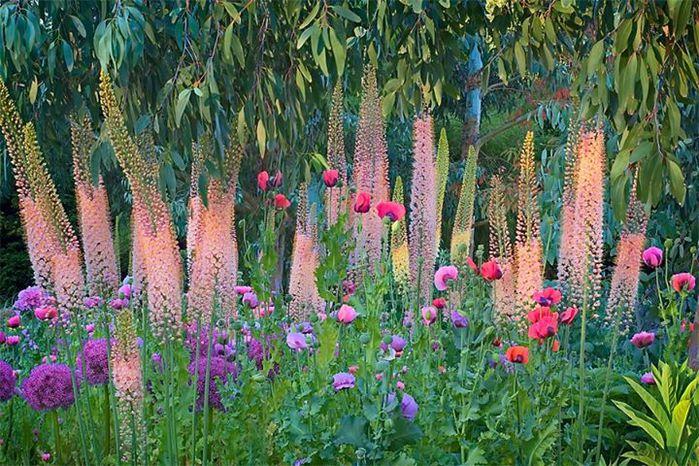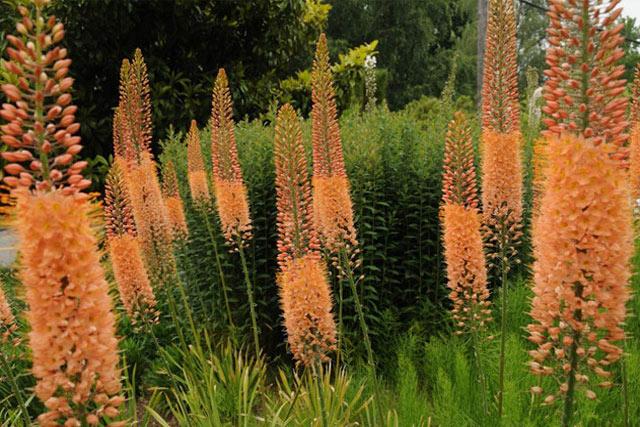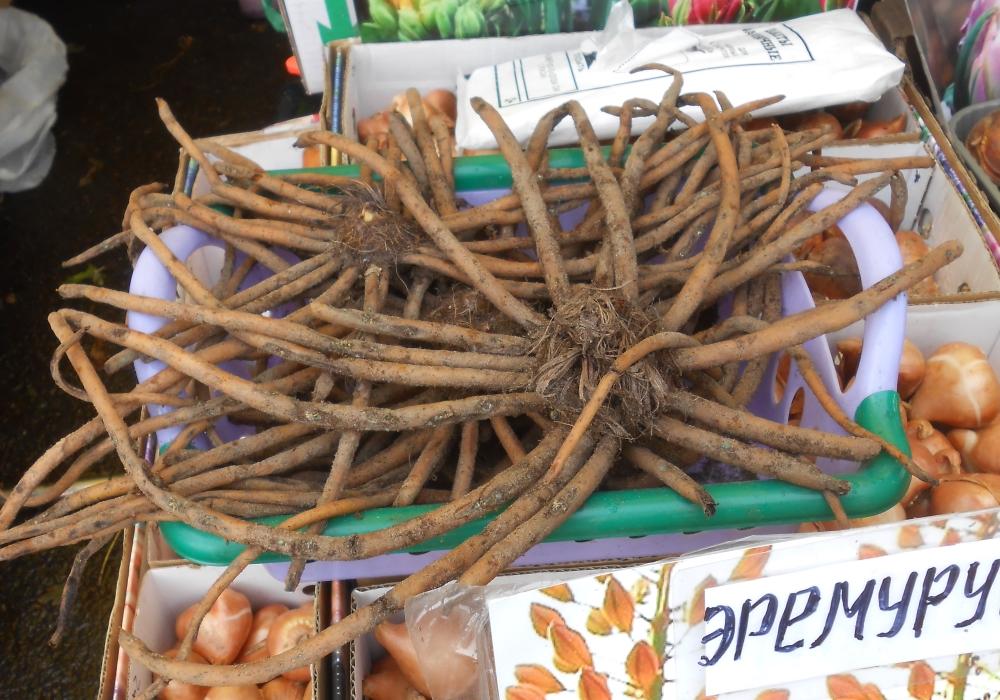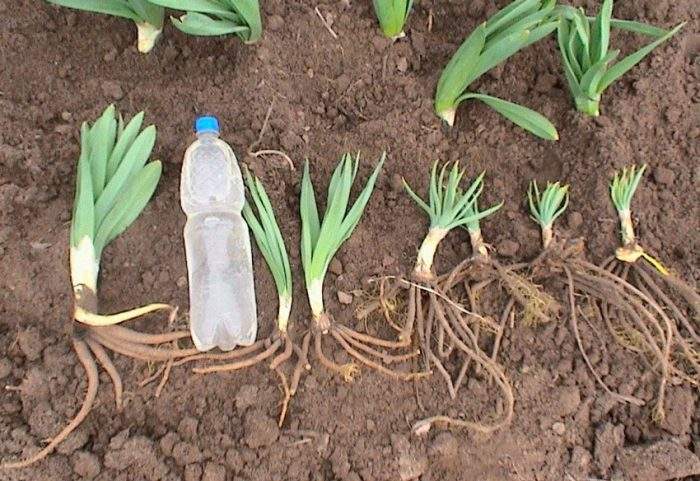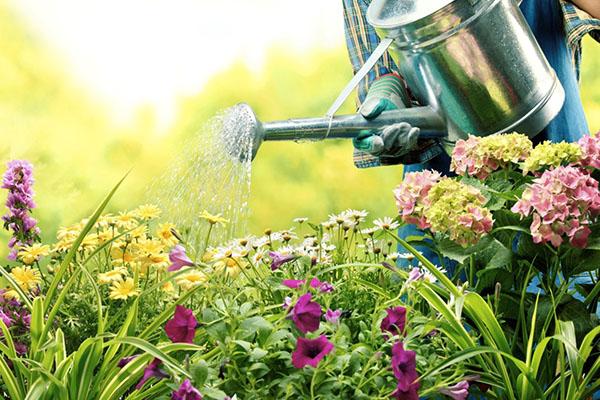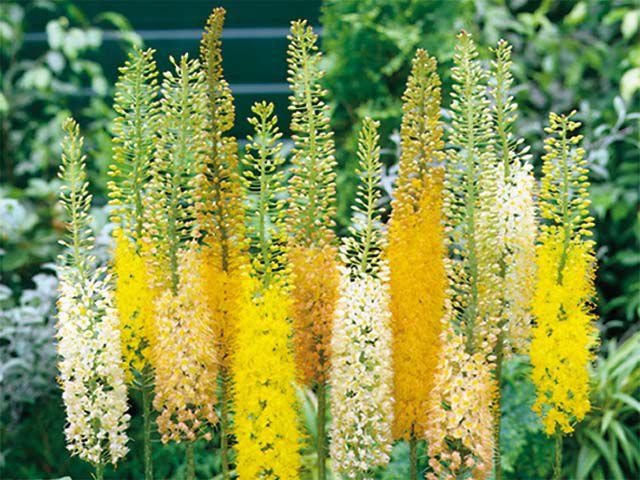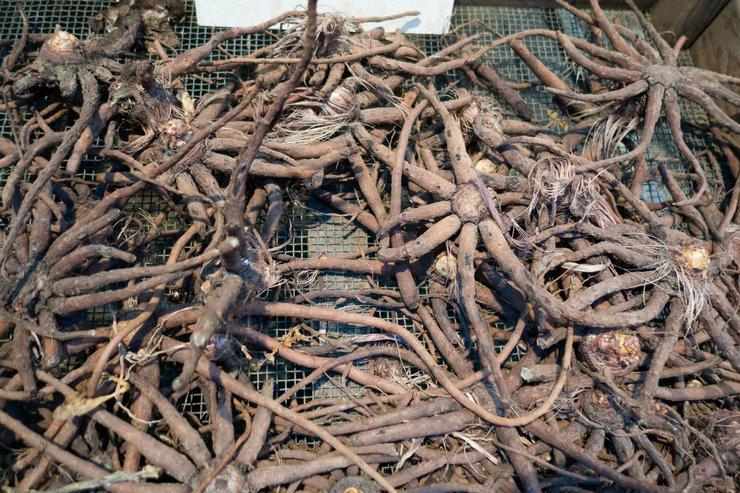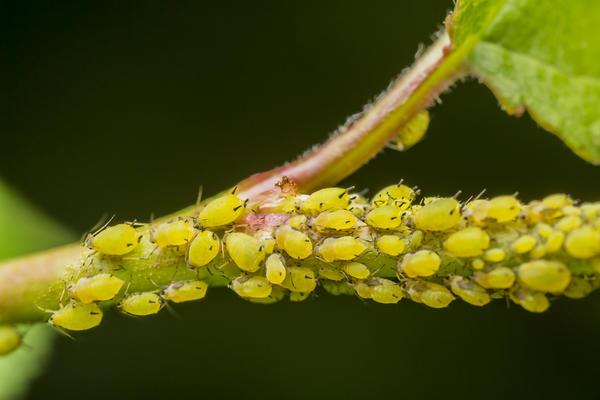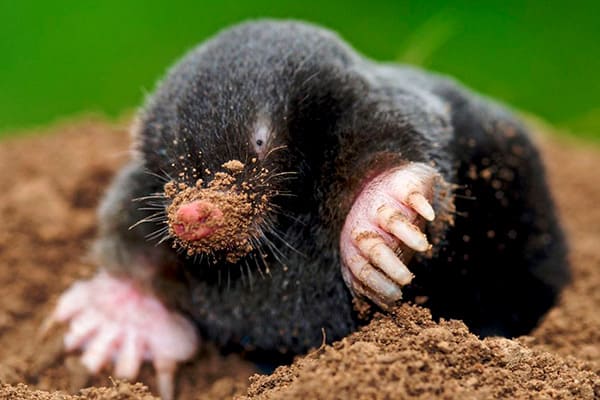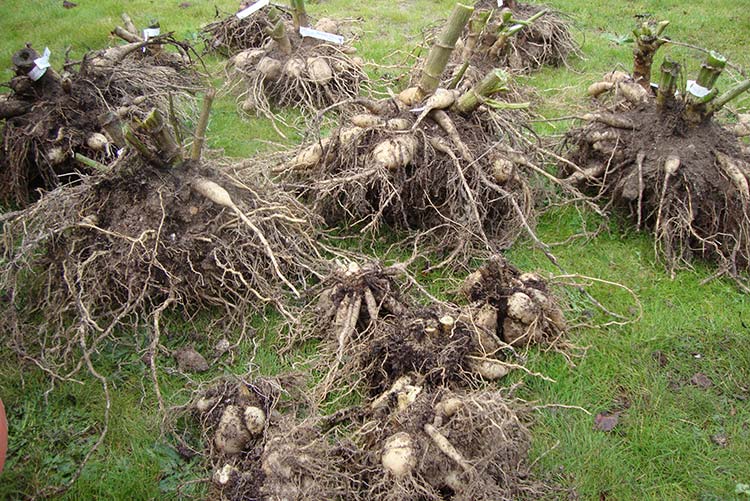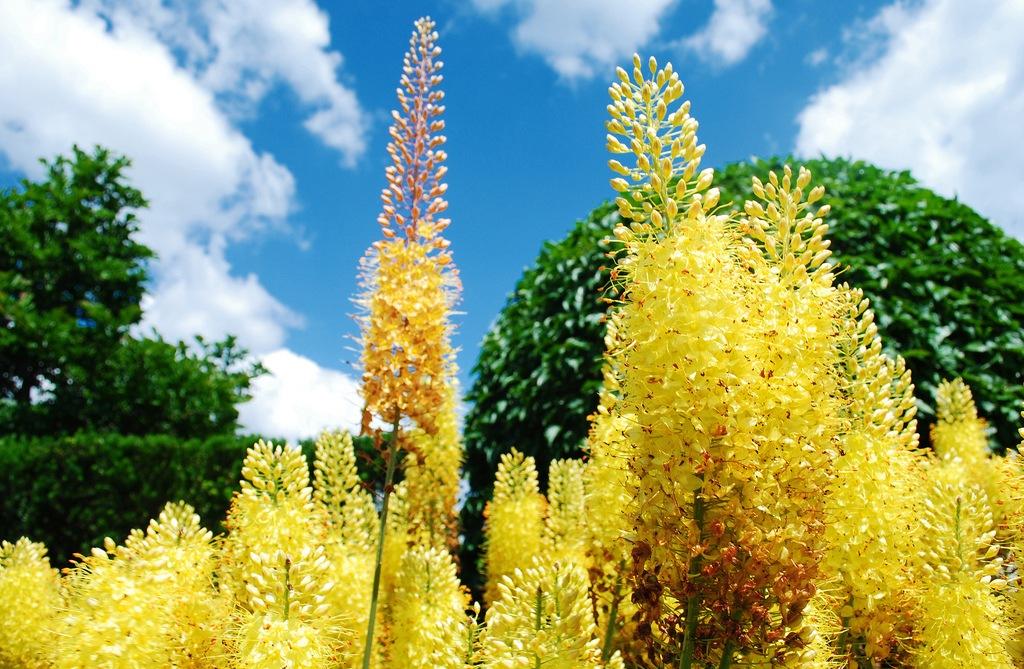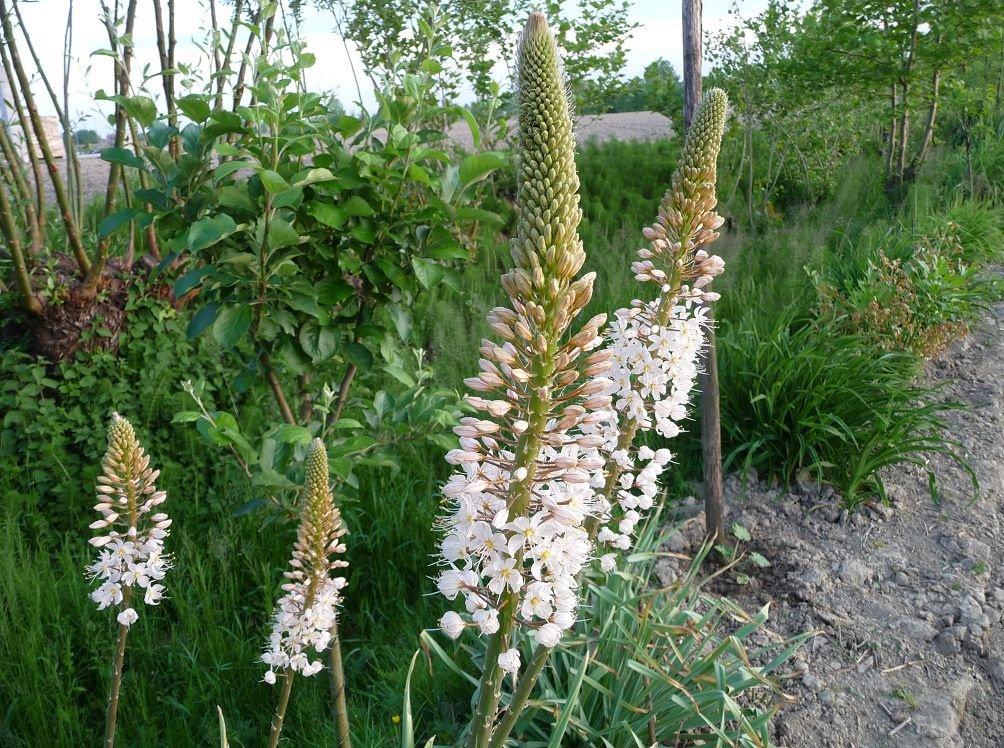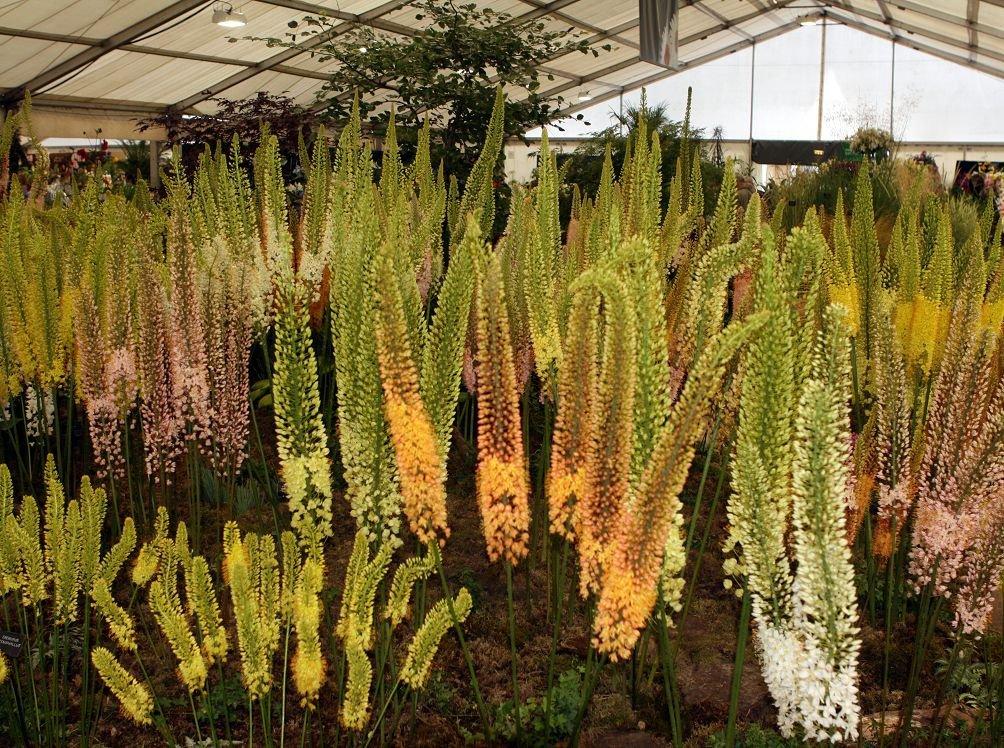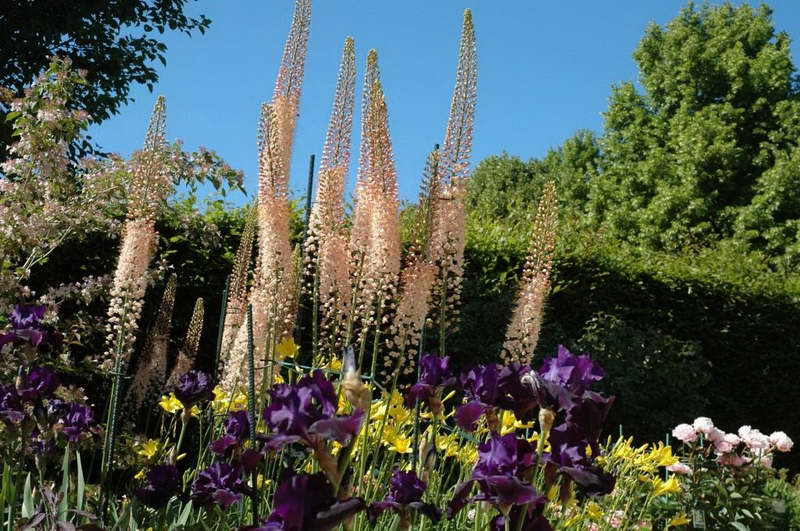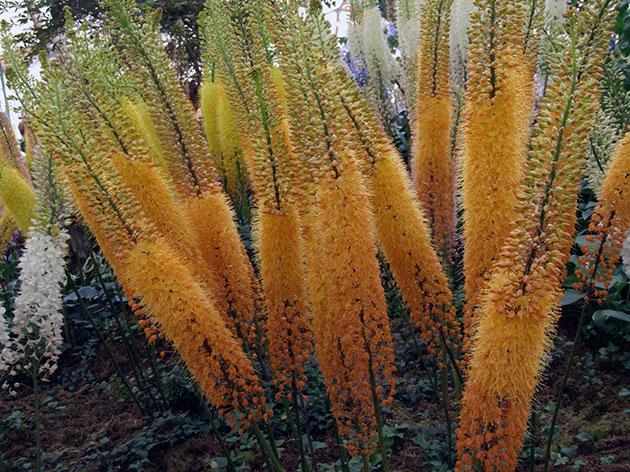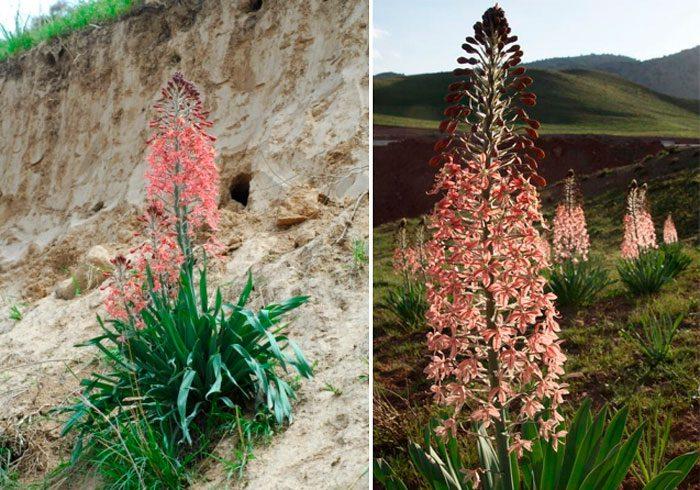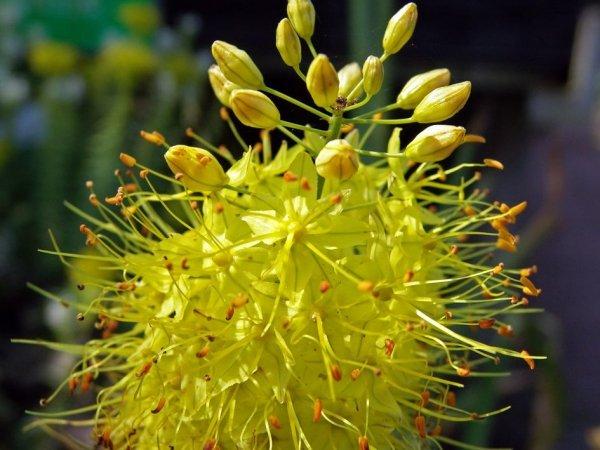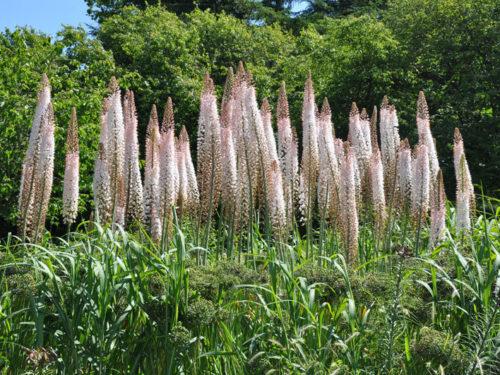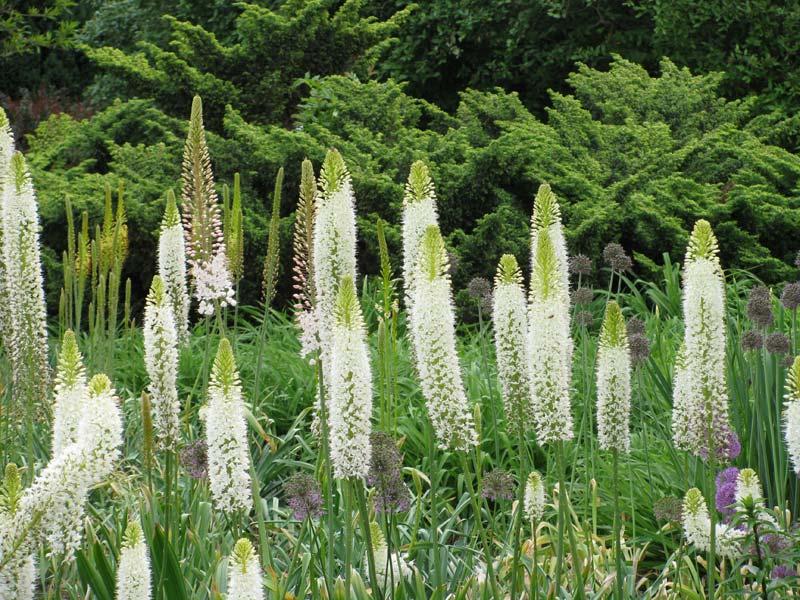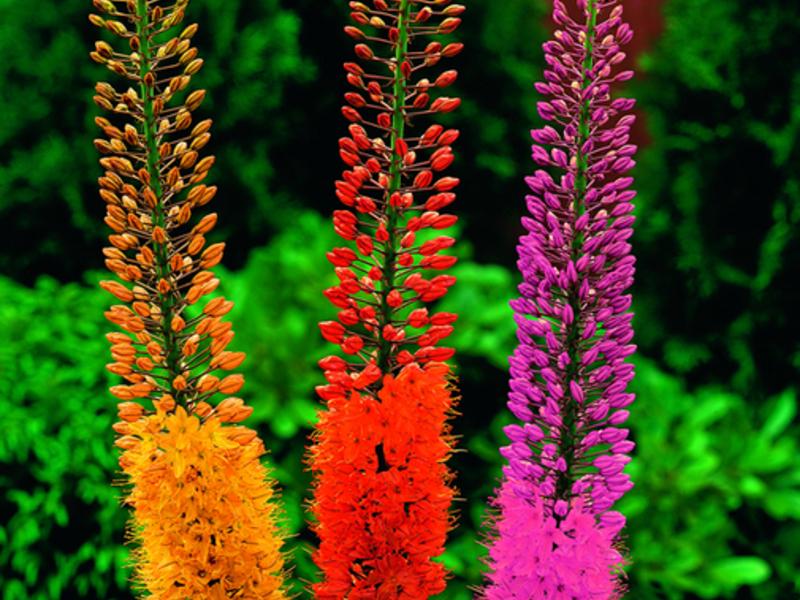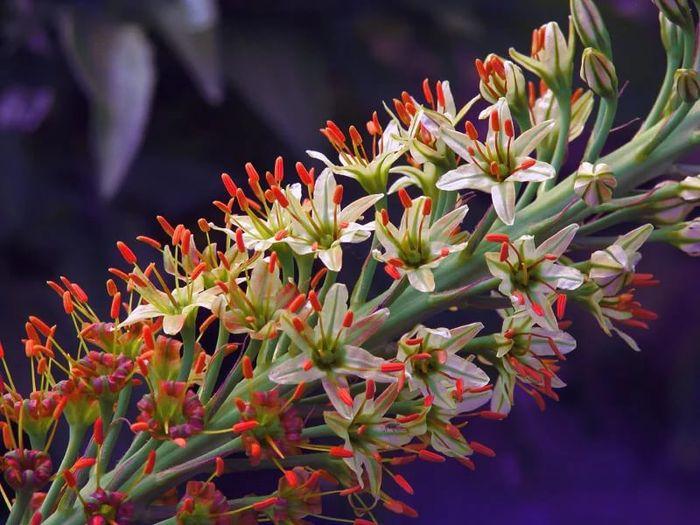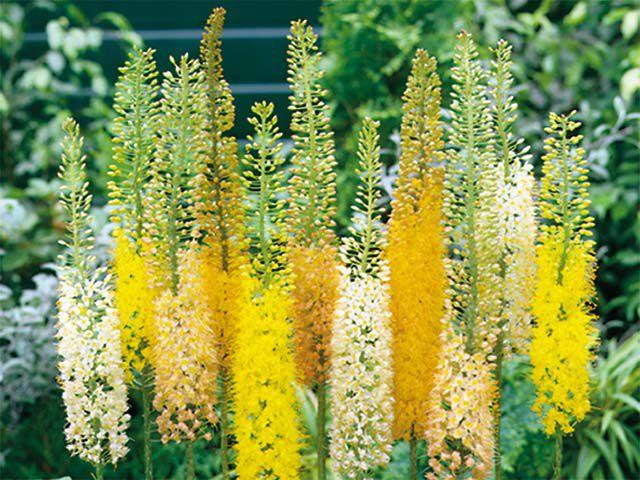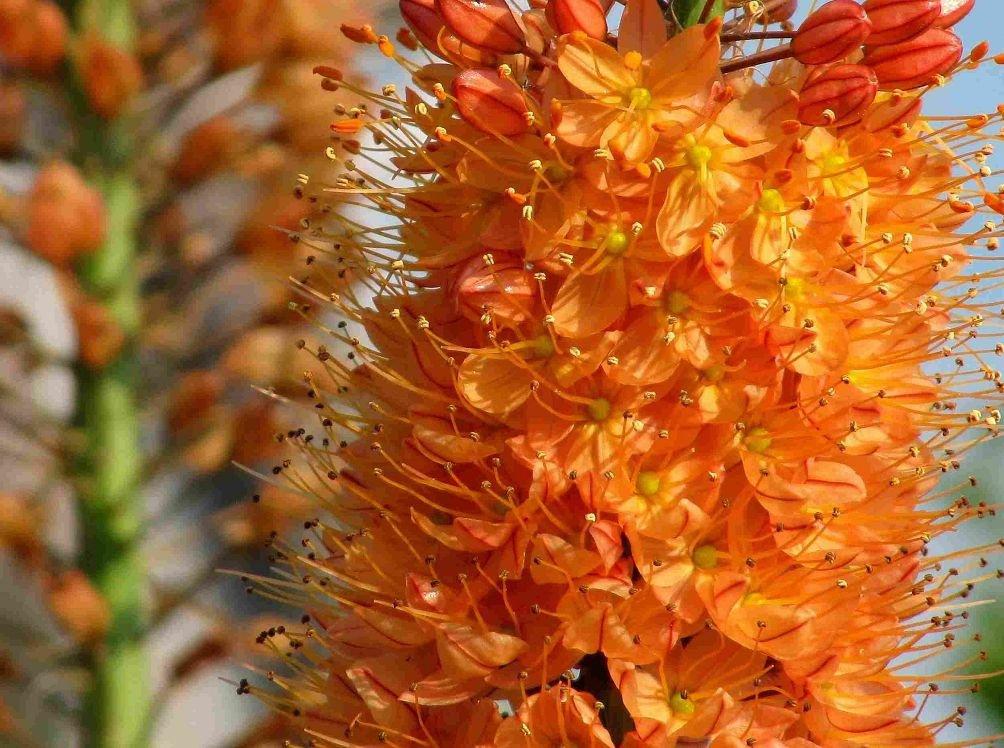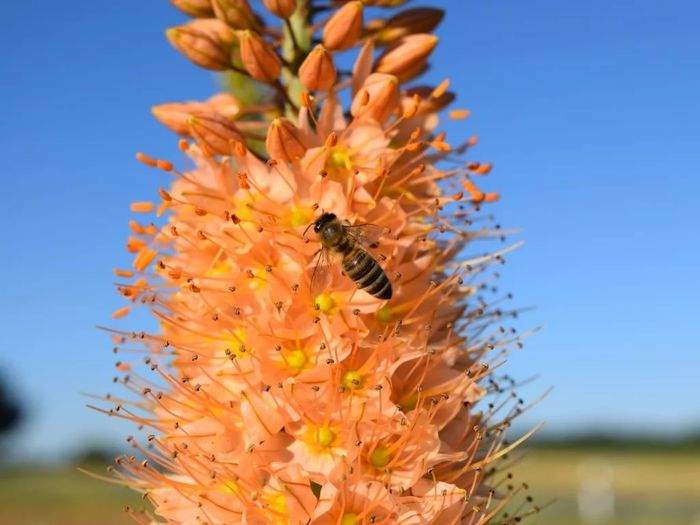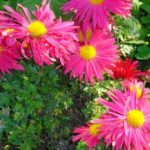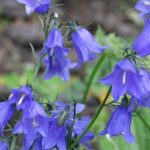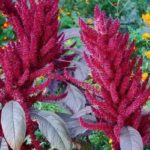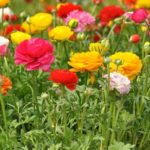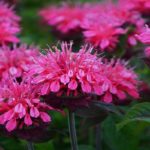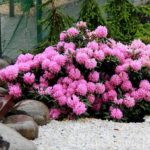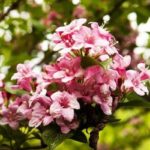Eremurus is a unique plant, planting and caring for which requires compliance with certain conditions. The culture is perennial and has a long growing period, but despite this, it is very often used by gardeners to decorate plots.
- Description and features
- Growing seedlings
- Deadlines
- How to plant correctly
- Watering
- Temperature and light conditions
- Picking
- Preparing for winter
- Planting in open ground
- Deadlines
- Selecting a location
- Soil requirements
- Planting scheme
- Care
- Watering
- Top dressing
- Loosening and weeding
- Storage during rainy periods
- Reproduction
- Generative
- Vegetative
- Diseases and pests
- Aphid
- Thrips
- Slugs
- Moles and mice
- Rust
- Chlorosis
- Viral disease
- After flowering
- Collection and storage of seeds
- Wintering
- Kinds
- Achison
- Alberta
- Powerful
- Olga
- Bunge
- Thunberg
- White-flowered
- Suvorov
- Tajik
- Crimean
- Tien Shan
- Turkestan
- Beautiful
- Sogdian
- Pinkish
- Regel
- Fluffy
- Comb-shaped
- Small-flowered
- Nuratovsky
- Amazing
- Yellow
- Kopetdag
- Korzhnisky
- Kaufman
- Junge
- Indersky
- Gissarsky
- Ilaria
- Zinaida
- Capus
- Himalayan
- Bukhara
- Wonderful
- Narrow-leaved
- Popular varieties
- Isobel
- Rosalind
- White beauty
- Moonlight
- Gold
- Citronella
- Lady Falmouth
- Sunset
- Don Dwarf
- Highdown Dwarf
- Golden Dwarf
- Cleopatra
- Pinocchio
- Obelisk
- Romance
- Rexona
- Bungei
- Ruteira
- Use in landscape design
Description and features
A distinctive feature of the plant is the shape of the root, which looks like a starfish. The leaves are oblong, elongated in shape. Bell-shaped flower. The inflorescences are collected in a panicle. The plant is perennial, has high winter hardiness; when cold sets in, the root forms a wintering bud, from which shoots appear after the soil warms up in the spring. The plant can reach a height of up to 2 meters depending on the variety.
Peculiarities:
- the plant blooms in a spiral, the flowers open starting from the root and gradually move upward;
- color duration is 30-40 days depending on the variety;
- After flowering ends, a fruit is formed that contains seeds.
The inflorescences can be of different colors, but the most common are yellow, brown, red and pink shades.
Growing seedlings
The plant has a long development time, so before planting in the ground it is necessary to grow seedlings.
Deadlines
To obtain seedlings, you need to plant the seeds in the ground. Autumn is the right time to plant seeds.Planting material is planted in September - early October. After germination, the seedlings must be planted in seedling containers.
How to plant correctly
In order for the seed material to germinate quickly, it is necessary to follow the following algorithm of actions:
- prepare a box for planting seeds;
- fill with sand and peat soil;
- make small holes 1-1.5 cm and plant seeds;
- Sprinkle soil on top without compacting.
Seeds have a long germination period, so it is necessary to regularly monitor the condition of the soil.
Watering
For the first 3-4 weeks after planting, regular watering must be observed. The soil should dry out between irrigations. After the 5th week after planting in the ground, the crop must be watered once a week.
Temperature and light conditions
After planting in the ground, it is necessary to maintain a temperature of at least 25 degrees and bright light for the first 4 weeks. After which the box is moved to places with a temperature of no more than 15 degrees, without exposure to sunlight.
Picking
Shoots appear 5-8 months after planting in the ground. In order for the plant to develop well, it is necessary to plant the seedlings. Individual flower pots or a large box can be used. A distance of at least 10 cm must be maintained between seedlings.
Preparing for winter
In winter, the plant must be covered with a layer of leaves, the thickness of the layer should be at least 20 cm. After spring comes, the leaves are removed and the usual care of the crop is carried out.
Important. For planting a plant with seeds, the most suitable seed material is taken from the lower part of the inflorescence.
Planting in open ground
The plant is very demanding to care for, so planting in open ground requires regular watering and loosening the soil.
Deadlines
It is recommended to plant the plant with seeds in open ground in the spring after the soil has warmed up. However, the most suitable growing method is to plant seedlings. Seedlings are planted in September. The seedlings must be at least 3 years old.
Selecting a location
When choosing a planting location, you should give preference to well-lit areas. Regular sunlight allows you to get large inflorescences and a healthy plant. The planting site should be protected from winds, and special supports should be installed to reduce the risk of damage to the stems.
Soil requirements
The plant prefers soil that is neutrally acidic. The most optimal is considered to be a prepared mixture of 2 parts of soil mixed with one part of peat and sand, 1 part of wood ash.
Planting scheme
In order to plant Eremurus, you must follow these steps:
- make a hole up to 25 cm deep;
- a layer of pebbles is placed at the bottom of the hole for drainage;
- the sprout is carefully placed in the recess and the roots are straightened;
- the hole is filled with the nutrient mixture and compacted a little;
- Using warm water, you need to water the hole with the seedling.
The distance between seedlings should be at least 45 cm, since the root grows in width and requires free space.
Care
For rapid development of the crop and reduction of diseases, it is necessary to observe proper care of the seedling.
Watering
The plant must be watered abundantly every 2-3 days until July, but if regular rains are observed, irrigation is reduced. After the plant produces buds, watering is reduced to once every 6-7 days.
Top dressing
Fertilizing is carried out according to the following scheme:
- compost is added in the spring;
- in mid-summer, before flowering, phosphorus and potassium are added;
- in the fall it is necessary to add superphosphate and humus.
If poor plant development is observed, it is necessary to additionally apply complex fertilizers.
Loosening and weeding
It is recommended to remove weeds manually in order to reduce the risk of damage to the roots. The soil is loosened regularly before watering. This is necessary to reduce diseases and saturate the soil with oxygen.
Storage during rainy periods
Prolonged rains lead to damage to the plant root; in order to avoid this problem, you must follow the following tips:
- regularly loosen the soil so that there is no risk of root rot;
- install a drainage system;
- Hill up the plants so that the liquid can drain.
However, in cases where there is a long rainy summer, it is necessary to carefully dig up the crop and store it in a dry place.
Reproduction
The plant propagates in two ways; gardeners choose the appropriate method according to individual preferences.
Generative
After the plant has flowered, seed boxes will appear; after the seed box has fully matured, it is necessary to collect the planting material and treat it with an antiseptic. Dry the seeds and plant them in the soil.
Vegetative
It involves dividing the mother root into several parts. To do this, carefully remove the layer of soil, exposing the roots. Using a sharp knife, you need to divide the root into several parts. Each part must have a kidney. The cut areas must be treated with charcoal.
Parts of the root must be placed in a dry place and left for a month. Then plant the shoots in the ground.
Important. An adult plant can be used for propagation once every 5-6 years.
Diseases and pests
The plant has succulent stems, so it often attracts pests with its appearance. Also, improper care of crops leads to the formation of diseases.
Aphid
The plant is very often affected by a pest such as aphids. The insect feeds on sap and also secretes a specific sticky liquid that provokes the development of fungal diseases. To remove aphids, it is necessary to spray with a soap solution. Once every 2-3 days until the insect completely disappears.
Thrips
Small pests that damage plant leaves and stems and lead to their drying out and gradual death. The first symptoms of infection are the appearance of yellow spots and scratches on the plant. To treat the plant, it is necessary to spray with the following preparations: Fitoverm, Actellik.
Slugs
Slugs provoke the development of fungal diseases and in large numbers can lead to the death of the crop. If there is a small accumulation of the pest, they can be collected manually. Elimination of slugs can be carried out using special traps. A small container of beer is placed in the soil so that the edge of the trap is level with the ground. Slugs die when caught in a trap.
Moles and mice
Pests damage the root, which ultimately leads to the death of the plant. The first symptoms of root damage are plant lethargy and yellowing of the leaves. Getting rid of pests is very difficult. To treat a plant, it is necessary to identify damaged areas, remove them and treat them with charcoal.
Rust
The disease is manifested by yellowing of leaves and the presence of dark spots of various shapes. The disease can develop quickly and ultimately leads to the death of the crop.If the first symptoms are present, the damaged leaves are removed and the plant is treated with Topaz or Fitosporin.
Chlorosis
The disease is manifested by the presence of yellow spots on the leaves; in some cases, the plant may wither and become covered with a white coating. To treat the problem, the drug “Barrier” or “Topaz” is used.
Viral disease
This type of problem manifests itself in the presence of yellow spots on the leaves, the appearance of growths and irregularities on the stems, and the flowers are deformed. The virus is most often transmitted by pests or weeds. Viruses on plants cannot be treated; to prevent further spread of the problem, the damaged flower is removed along with the root. The growth site is treated with a manganese solution.
After flowering
After the plant has flowered, it is necessary to provide it with proper care. This will help saturate the roots with the necessary beneficial components before winter.
Collection and storage of seeds
The seed boxes are cut at the end of August and placed in a ventilated room for drying. At the end of September, the boxes are opened, the seeds are laid out on a flat surface and left for several days. The finished seeds are placed in a fabric bag and stored until planted in the ground.
Wintering
In October, flower stems are trimmed using garden shears. The roots are covered with peat or humus. A layer of fallen leaves or spruce branches is placed on top and left until spring. In winter, it is recommended to additionally use a layer of snow in places where Eremurus grows.
Kinds
There are a large number of plant species that have distinctive characteristics.
Achison
The plant species belongs to one of the early flowers and begins to form buds already in April. The plant may have white or pink inflorescences.The flower is 1.5 meters tall, the panicle length is 90 cm.
Alberta
Most often found in mountainous areas, the plant height is 1 meter. Leaves are straight. The inflorescences are red with a white border. The panicle is fluffy, up to 50-55 cm long.
Powerful
The leaves are light green, erect. The height of the crop reaches up to 1.3 meters. The panicle consists of small white buds; pink inflorescences may be found.
Olga
The culture reaches a height of up to 1.6 meters. The plant has lush inflorescences up to 50 cm long. The color of the inflorescences is white. Blooms gradually, starting in June.
Bunge
A distinctive feature of the plant is its bright inflorescences, which are yellow in color. The height of the crop can reach up to 2 meters. The flowers are large, up to 5-6 cm in diameter. The winter hardiness of the crop is high. Can be grown in any conditions.
Thunberg
The height of the bush reaches 1.5 meters. The plant is a hybrid. The panicles with flowers are dense, gray-yellow in color.
White-flowered
The height of the bush is 1 meter. The brush is 35 cm long, not too dense. The flowers are white and reach up to 4-5 cm in diameter. The leaves are light green and erect.
Suvorov
The height of the plant is 1.2 meters. Prefers hilly terrain. One bush can have up to 35 leaves. Erect green leaves. The flowers are shaggy, off-white in color, with a green streak.
Tajik
Prefers desert climate. The height of the bush is 1.3 meters. The leaves are light green, with a slight bluish tint. A raceme of inflorescences 40 cm long, cream-colored flowers. On average, the flower reaches 2.5 cm in diameter.
Crimean
The leaves of the plant have a slight roughness. The cluster of inflorescences is dense and can be up to 60 cm in length.The height of the bush is 1.5 meters. The inflorescences are white with green veins.
Tien Shan
Most often the flower grows in steppe areas. The height of the bush can reach up to 1.8 meters. The leaves are dark green, erect, up to 25 pcs. The buds are pale pink. The diameter of the flower is up to 5 cm.
Turkestan
The low bush reaches a height of up to 1 meter. The leaves are wide, in the amount of 10-15 pieces. The inflorescence is pale yellow, the diameter of the bud is 2 cm. The panicles are dense, up to 20 cm long.
Beautiful
Prefers rocky areas, but is widespread in almost all regions. The height of the crop can reach 2 meters. The leaves are small, in the amount of 6-10 pieces. The stem is bare, the buds are white-yellow.
Sogdian
The height of the bush is 1.2 meters. The leaves are linear, glabrous, 8 pieces per stem. The inflorescences are shaggy, white with a brown streak. The length of the brush can be 50 cm.
Pinkish
Bush up to 1.4 meters high. The leaves are densely arranged on the stem, keeled in shape. The inflorescences are large, pale pink.
Regel
The bush reaches a height of up to 2 meters. The leaves are wide, green, with a bluish bloom. The brush is dense, up to 70 cm long. The flowers are purple with a pink border. Blooms in mid-May.
Fluffy
Bush up to 1.5 meters high. The leaves are erect, with slight roughness along the edges. The brush is dense and fluffy. The flowers are lilac, with pink splashes. Blooms in mid-May.
Comb-shaped
The plant prefers open areas. The height of the bush is 1.4 meters. The flowers are brown-green. The brush is curved and dense. The crop is predominantly propagated by seeds without loss of maternal characteristics.
Small-flowered
The height of the bush is only 70 cm. The flowers are white with brown veins, small in size, 0.5 cm wide. The plant blooms mainly in mid-April.
Nuratovsky
It is a rare plant species. The height of the bush is only 1.1 meters. Blooms in May. The flowers are white, shaggy, with brown veins. It is found very rarely, mainly in mountainous areas.
Amazing
Bush up to 1 meter high. The stem is thin, the leaves are narrow and rough. The plant blooms in mid-spring. The brush is dense, light pink in color. The buds are large, up to 4 cm in diameter.
Yellow
The bush is small in size and most often has a height of no more than 70 cm. It can be found in Iran. The brush is small in size, yellow in color. The plant has a bright aroma. Can be used for cutting and arranging bouquets.
Kopetdag
The height of the bush is 60 cm, the leaves are green, triangular, with a smooth surface. The raceme is small, with pale pink flowers.
Korzhnisky
Bush up to 1.5 meters high. Blooms mainly in mid-summer. The flowers are yellow with brown veins, a small raceme of loose structure.
Kaufman
The height of the bush can vary from 60 cm to 1.2 meters. The leaves are green, covered with white fibers. The stem is fleshy, the panicle with buds is dense. White. The plant blooms in mid-June.
Junge
Plant up to 1.8 meters high. Very rare. The flowers are lily-shaped. Inflorescences are sulfur-yellow. Blooms in mid-summer.
Indersky
The height of the bush is 1 meter. The stem is dense with a white coating. The flowers are pinkish-green, slightly tilted back. Begins to bloom in mid-May depending on weather conditions.
Gissarsky
The culture can reach a height of up to 1.3 meters. The leaves are straight with a smooth surface. The stem is fleshy, the flowers are brown and medium in size. The panicle is 40 cm long. It tolerates changes in temperature well and can be grown in various conditions.
Ilaria
The bush is 80 cm high. It is distinguished by the attractive color of the buds, which can be white or cream in color. The crop begins to bloom in mid-April. It has a pleasant smell.
Zinaida
The height of the bush is 90 cm. The leaves are up to 0.5 cm wide. The buds are pink with a purple border. The brush is small, only 20 cm.
Capus
A low bush that reaches 50 cm. The leaves are light green with a whitish coating. The flowers are white and begin to bloom in mid-March. The buds are small and form a dense panicle.
Himalayan
The height of the plant is 1.7 meters. The leaves are distinguished by their bright green color. The inflorescences are white with a brown vein. Form a dense panicle, slightly tilted back.
Bukhara
Bush 1.3 meters high. The leaves are straight with a bluish bloom. The stem has small white fibers. The buds are pale pink, slightly inclined downwards. Begins to bloom in mid-June.
Wonderful
Culture up to 1.5 meters high. The leaves are triangular, bright green. The flowers are bell-shaped and yellow. Brush 70 cm long.
Narrow-leaved
The plant species prefers shady areas, the height of the bush is 1.5 meters. The leaves are elongated, smooth, with a slight bluish bloom. The brush is fluffy, yellow. Begins to bloom in mid-June.
Popular varieties
Among the large list of crop varieties, the most commonly used varieties stand out.
Isobel
The culture has an attractive bud color.The flowers are pink-orange and large in size. The bush grows up to 1.4 meters high.
Rosalind
A distinctive feature of the culture are the buds of a soft pink color. The bush reaches a height of up to 1.5 meters. The leaves are green with a slight bloom. They bloom most often in mid-June.
White beauty
The height of the bush is 90 cm. The flowers are white. The panicle with buds is dense, up to 40 cm long. It blooms in mid-June.
Moonlight
The plant has yellow flowers, which can reach up to 3 cm in diameter. The height of the bush is 1.3 meters. Prefers sunny areas for planting.
Gold
The plant is tall. The height of the stem can reach 2 meters. The inflorescences are yellow with hints of pink. The panicle is not dense, up to 70 cm long.
Citronella
The plant can come in a variety of colors, but yellow and salmon are the most common. Tolerates low temperatures well. With proper care it reaches a height of 1.2 meters.
Important. The culture does not tolerate excessive moisture. Therefore, when planting in the ground, it is necessary to avoid places with groundwater located close to the surface.
Lady Falmouth
The culture is tall. Can reach up to 1.6 meters. The cluster with buds is loose, the flowers are medium-shaped, cream-colored. Bell-shaped buds.
Sunset
The stem of the crop reaches 1.7 meters. The flowers are salmon-colored with hints of red. The leaves are triangular, smooth, erect. The brush reaches a length of 80 cm.
Don Dwarf
Small bush. Can reach up to 1 meter. The flowers are yellow. The panicles are parallel and bell-shaped.
Highdown Dwarf
It belongs to the tall species, reaching a height of up to 2 meters. May be different shades of yellow.The brushes are dense and can reach sizes up to 90 cm. It blooms in mid-summer.
Golden Dwarf
A distinctive feature of the flower is the bright yellow color of the buds. Stamens are longer than inflorescences. The brush is fluffy, up to 80 cm long.
Cleopatra
The plant has a bright coral color, which attracts and stands out among other crops. The height of the plant is 1.1 meters.
Pinocchio
Bush 1.4 meters high. The flowers are yellow with gray impurities, the stamens stand out with a cherry tint.
Obelisk
The leaves of the plant are straight, triangular. The flowers are white with a bright emerald center. It has a pleasant smell.
Romance
Plant height is 1.2 meters. Blooms in mid-May, early June depending on weather conditions. Salmon-colored buds with pink border.
Rexona
Bush up to 1.3 meters high. The inflorescences are orange in color. The stem is thin, practically without leaves. Blooms in mid-June.
Bungei
The culture has a bright yellow bud color with minor impurities of a golden hue. After wilting, the buds turn brown. A plant up to 1.4 meters high can grow in the shade.
Ruteira
The culture can be of different shades: from yellow to pale pink. With proper care it reaches a height of 1.1 meters.
Use in landscape design
Eremurus goes well with various types of plants. Can be used as the main crop on the site. However, it is most often used as compositions with other types of flowers that are short in stature.
Eremurus has an attractive appearance and can decorate any garden. Proper care will preserve the beauty of the plant for a long period without reducing its overall characteristics.

